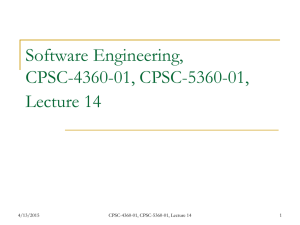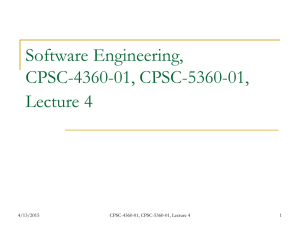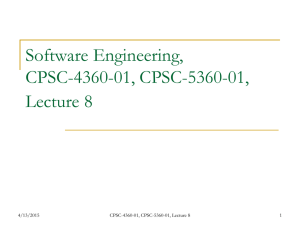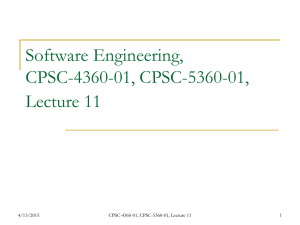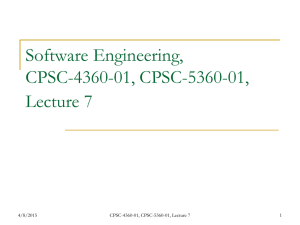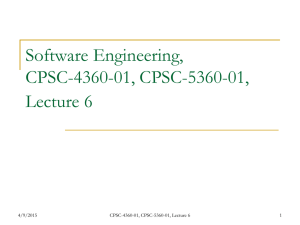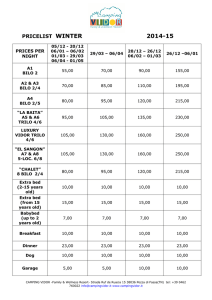Lecture 3
advertisement
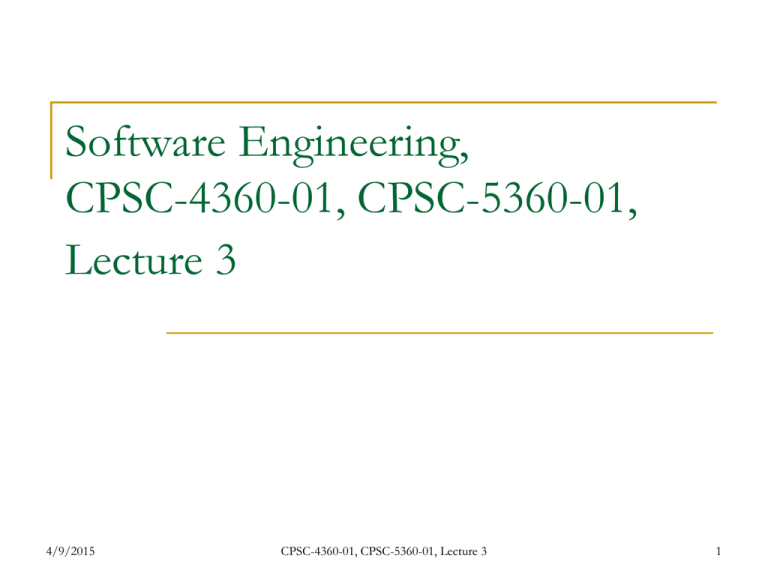
Software Engineering, CPSC-4360-01, CPSC-5360-01, Lecture 3 4/9/2015 CPSC-4360-01, CPSC-5360-01, Lecture 3 1 Overview of the Last Lecture Software Development Models Waterfall Model Evolutionary Models Incremental Model Spiral Model Unified Process Overview of UML 4/9/2015 History 4 + 1 View models Using UML in UP CPSC-4360-01, CPSC-5360-01, Lecture 3 2 Overview of This Lecture Introduction to Case Studies Requirement Gathering Use Case Modeling Domain Modeling / Business Modeling Activity Diagram 4/9/2015 CPSC-4360-01, CPSC-5360-01, Lecture 3 3 Case Study 1: The Restaurant Example developed in the Practical ObjectOriented Design With UML by Mark Priestley, chapter 4. Support the day-to-day operations of restaurant by improving the processes of: Making Reservations Allocating Tables Current System is based on manual booking system: 4/9/2015 Hand-written forms in large folder. CPSC-4360-01, CPSC-5360-01, Lecture 3 4 Case Study 1: The Restaurant Current system uses manual booking sheets. 4/9/2015 CPSC-4360-01, CPSC-5360-01, Lecture 3 5 Case Study 1: The Restaurant Three sittings (slots) in an evening Each Booking records: Booking can span more than one slot Contact Name and Phone Number Annotation made for various events: 4/9/2015 Arrival of customer (Cross out record) Table switch (Arrow to new table) Cancellation Time to vacate “Walk-In” Customer CPSC-4360-01, CPSC-5360-01, Lecture 3 6 Case Study 1: Restaurant Problems with the manual systems: Slow Confusing and difficult to read No backup copies Hard to get useful management data Develop an automated computerized version. 4/9/2015 CPSC-4360-01, CPSC-5360-01, Lecture 3 7 Case Study 2: The Monopoly Game Chosen because of its familiarity. A game played almost in every country. Developed in the Applying UML and Patterns by Craig Larman, Chapter 3. The software version will run as simulation: 4/9/2015 User starts the simulation by indicating the number of simulated players. All turns are simulated with result (trace) printed. CPSC-4360-01, CPSC-5360-01, Lecture 3 8 Case Study 3: The Bicycle Renting Adopts a use-case driven object-oriented approach to develop a system to support the process of bicycle renting in a kiosk at East Coast Park, Singapore. Developed in the Software Engineering: An objectoriented approach by Bimlesh Wadhwa, Stefan Andrei, Soo Yuen Jien, 2007, McGraw Hill. 4/9/2015 CPSC-4360-01, CPSC-5360-01, Lecture 3 9 Where are we now? Requirement Requirement Gathering Analysis Design Implement Understanding the requirements. Business Modeling Understanding the problem domain. Test 4/9/2015 CPSC-4360-01, CPSC-5360-01, Lecture 3 10 Requirement: Overview Early phase of the development. Inputs: informal specification. Activities: 4/9/2015 create use case model. define use cases. create domain model. create glossary. create activity diagram. CPSC-4360-01, CPSC-5360-01, Lecture 3 11 Use Case View Intended to provide a structured view of the system's functionality. Description of how users interact with the system. Supported by UML use case diagrams. Serves as the starting point for all subsequent development. Three important definitions: Use Case Scenario Actor 4/9/2015 CPSC-4360-01, CPSC-5360-01, Lecture 3 12 Use Case and Scenarios Use Case: The different tasks that users can perform while interacting with the system. Scenarios: Are particular instances of the use case: Basic Course of Events: normal flow. Alternative Course of Events: optional flow. Exceptional Course of Events: erroneous flow. 4/9/2015 CPSC-4360-01, CPSC-5360-01, Lecture 3 13 Actor Roles played by users when interacting with a system, e.g.: Receptionist (makes bookings); Head waiter (assigns tables etc). Individual user may play one or more roles at different times. Often corresponds to certain level of access, e.g., logging into Lamar website as Staff or Student. 4/9/2015 CPSC-4360-01, CPSC-5360-01, Lecture 3 14 Use Case Diagram UML diagram to summarize the relationship between actors and use cases. Diagram Element: Actor Communication Use Case <<Include>> Inherit (Actor Relationship) 4/9/2015 Constraints CPSC-4360-01, CPSC-5360-01, Lecture 3 <<Extend>> Use Case Dependency 15 Case Study 1: Use Cases A preliminary list of use cases: 1 Record new booking. 2 Cancel a booking. 3 Record customer arrival. 4 Transfer a customer from one table to another. 4/9/2015 CPSC-4360-01, CPSC-5360-01, Lecture 3 16 Case Study 1: Use Case Diagram Show use cases, actors and who does what. System 4/9/2015 CPSC-4360-01, CPSC-5360-01, Lecture 3 17 Use Cases Description A use case comprises all the possible interactions that a user can have when performing a given task. Often a dialogue between system and user. These are described as courses of events, or scenarios. A full description of a use case includes: a basic course of events; a number of alternative and exceptional courses. 4/9/2015 CPSC-4360-01, CPSC-5360-01, Lecture 3 18 Basic Course of Events Describes what happens in the ‘normal’ case. For example, for ‘Record Booking’: Record Booking: Basic Course of Events Receptionist enters date of requested reservation; System displays bookings for that date; There is a suitable table available: Receptionist enters details (customer’s name, phone number, time of booking, number of covers, table number); System records and displays new booking. 4/9/2015 CPSC-4360-01, CPSC-5360-01, Lecture 3 19 Use Case Templates UML does not define a standard format for use case descriptions. Various templates have been defined to structure descriptions. Essentially a list of subheadings such as: Name Actors Courses of events 4/9/2015 CPSC-4360-01, CPSC-5360-01, Lecture 3 20 Other Use Case Description Template This version emphasizes the exchange between user and system, e.g.: Actor System 1. Receptionist enters date of requested reservation; 2. System displays bookings for that date. 3. there is a suitable table 4. System records and available: Receptionist displays new booking. enters details (customer’s name, phone number, time of booking, number of covers, table number); 4/9/2015 CPSC-4360-01, CPSC-5360-01, Lecture 3 21 User Interface Prototype During the use case modeling activity, it is usually useful to have a rough idea of the user interface, e.g.: 4/9/2015 CPSC-4360-01, CPSC-5360-01, Lecture 3 22 Alternative Courses of Events Describe predicted alternative flows. For example, if no table is available: Record Booking – No Table Available: Alternative Course of Event 1 2 3 4/9/2015 Receptionist enters date; System displays bookings; no table available: end of use case. CPSC-4360-01, CPSC-5360-01, Lecture 3 23 Exceptional Courses of Events Situations where a mistake has been made. E.g., allocate a booking to a small table: Record Booking – table too small: Exceptional course of events 1 receptionist enters date; 2 3 4 5 6 4/9/2015 system displays bookings; receptionist enters details; system asks for confirmation of oversize booking; if “no”, use case terminates with no booking made; if “yes”, booking recorded with warning flag. CPSC-4360-01, CPSC-5360-01, Lecture 3 24 Shared Functionality Different use cases can overlap. E.g., ‘Record Arrival’: Record Arrival: Basic Course of Events 4/9/2015 head waiter enters date; system displays bookings; head waiter confirms arrival for booking; system records this and updates display. First two steps shared with ‘Record Booking’ (even though different actor). CPSC-4360-01, CPSC-5360-01, Lecture 3 25 Use Case Inclusion Move shared functionality to a separate use case: Display Bookings: Basic Course of Events user enters a date; system displays bookings for that date. Include this in other use cases, e.g.: Record Booking: Basic Course of Events (revised) receptionist performs Display Bookings; receptionist enters details; system records and displays new booking. 4/9/2015 CPSC-4360-01, CPSC-5360-01, Lecture 3 26 The <<include>> Dependency UML shows inclusion as a dependency between use cases, labelled with the stereotype <<include>> on the dashed arrow: System 4/9/2015 CPSC-4360-01, CPSC-5360-01, Lecture 3 27 Case Study 1: Use Case Diagram (Revised) Display booking System 4/9/2015 CPSC-4360-01, CPSC-5360-01, Lecture 3 28 Actor Generalization The last diagram shows that the Receptionist can performs the Display bookings use case independently from the Record Booking use case. Head Waiters can also performs Display bookings use case. Introduce a more general actor Staff to show what the other two actors have in common. The initial actors are specializations of the general actor. 4/9/2015 CPSC-4360-01, CPSC-5360-01, Lecture 3 29 Actor Generalization Notation System 4/9/2015 CPSC-4360-01, CPSC-5360-01, Lecture 3 30 Use Case Extension Recording a walk-in can be described as an exceptional course of events: someone arrives but there’s no booking recorded. It could also be a separate use case: a customer arrives and asks if there's a free table. Then, it can extend ‘Record Arrival’: even without a booking, the customer stays to eat. 4/9/2015 CPSC-4360-01, CPSC-5360-01, Lecture 3 31 Use Case Extension Record Walk-in: Basic Course of Events: 1 Head waiter performs Display Bookings use case; 2 Head waiter enters details (time, number of covers and the table allocated to the customer); 3 System records and displays new booking. Very similar to Record Arrival use case. Can we simplify? <<Include>> dependency is inappropriate. (why?) Record Walk-in is performed in some cases of Record Arrival, when there is no booking for the customer. 4/9/2015 CPSC-4360-01, CPSC-5360-01, Lecture 3 32 The <<extend>> Dependency Use case extension is shown with a <<extend>> dependency. Record walk-in optionally extends the functionality of Record arrival. States the constraint (condition) which causes the branch off. No Prior Booking System 4/9/2015 CPSC-4360-01, CPSC-5360-01, Lecture 3 33 Case Study 1: Complete Use Case Diagram System 4/9/2015 CPSC-4360-01, CPSC-5360-01, Lecture 3 34 Guidelines Use case: Should cover full sequence of steps from the beginning of a task until the end. Should describe user’s interaction with the system. Should not describe actual computations. Should be as independent as possible from any particular user interface design. Should only include actions in which the actor interacts with the computer. Use case diagram should be used to supplement the use case description, not as the main artifact. 4/9/2015 CPSC-4360-01, CPSC-5360-01, Lecture 3 35 Use Cases: Strengths Simple and Familiar Can be understood easily by untrained personnel, e.g., the customer. Involve the customer early in the development. Emphasize the user goals and perspective. Scale in term of sophistication and formality. 4/9/2015 CPSC-4360-01, CPSC-5360-01, Lecture 3 36 Use Cases: Problems Care must be taken to ensure the use cases are complete and unambiguous. Only actor initiated activities are recorded. Software requirement derived from use cases often mimics the manual system too closely. Preventing any innovative or more efficient way to be developed. 4/9/2015 CPSC-4360-01, CPSC-5360-01, Lecture 3 37 Domain Modelling Using UML diagram to construct a model of the real-world system: Understand the problem domain. Model recorded as a simplified class diagram. Seamless development: The same notation is used for analysis and design. The design can evolve from the initial domain model. 4/9/2015 CPSC-4360-01, CPSC-5360-01, Lecture 3 38 Domain Model Notation A subset of class diagram model elements are used. Class Name Attributes Name Multiplicity Multiplicity Association Class Class Generalization 4/9/2015 Constraints CPSC-4360-01, CPSC-5360-01, Lecture 3 39 Domain Model Notation Classes represent real-world entities. Attributes represent the data held about entities. Associations represent relationships between the entities. Generalization can be used to simplify the structure of the model. Constraints can be used to indicate conditions. 4/9/2015 CPSC-4360-01, CPSC-5360-01, Lecture 3 40 Case Study 1: Customers and Reservations Basic business fact: customers make reservations. 4/9/2015 CPSC-4360-01, CPSC-5360-01, Lecture 3 41 Defining a Relationship Give a name to the relationship: use a verb so that the relationship can be read as a sentence: A customer can make many reservations. How many people make a reservation? one principal contact whose details are held; that principal contact can make more than one reservation (e.g., by postponing the time); the expected number of diners can be modelled as an attribute of the reservation. 4/9/2015 CPSC-4360-01, CPSC-5360-01, Lecture 3 42 Case Study 1: Tables and Reservation Is table number an attribute of ‘Reservation’? Better modelled as a separate class: tables exist even if there are no reservations; other attributes of tables, e.g., size, can be stored. 4/9/2015 CPSC-4360-01, CPSC-5360-01, Lecture 3 43 Use of Constraints Not all domain properties can be shown graphically: e.g., it should be impossible to double-book a table. Constraints add information to models: written in a note connected to the model element being constrained. 4/9/2015 CPSC-4360-01, CPSC-5360-01, Lecture 3 44 Use of Generalization A superclass can be used to show the properties shared by different types of booking. 4/9/2015 CPSC-4360-01, CPSC-5360-01, Lecture 3 45 Correctness How do we know when a domain model is complete? we don't: there are lots of plausible models in most cases. Domain modelling is not an end in itself, but a guide to further development. Realizing use cases tests the domain model, and will usually lead to refinements. 4/9/2015 CPSC-4360-01, CPSC-5360-01, Lecture 3 46 Supplementary Documents Common Supplementary Documentation: Glossary: Glossary. Activity Diagram. A mini dictionary that captures concepts and vocabulary relevant in the problem domain. Avoids misunderstanding and facilitate communication. Activity Diagram 4/9/2015 UML diagram that describes activities. CPSC-4360-01, CPSC-5360-01, Lecture 3 47 Case Study 1: Partial Glossary Booking: an assignment of diners to a table. Covers: the number of diners for a booking. Customer: a person who makes a reservation. Reservation: a booking made in advance. Walk-in: a booking that is not made in advance. 4/9/2015 CPSC-4360-01, CPSC-5360-01, Lecture 3 48 Activity Diagram Similar to flow chart that describes sequence of activities. Useful in: Business Modelling (business workflow). Use Cases (interrelation and interaction). Design (algorithm, complex sequence etc). Often associated with several classes. One of the strengths of activity diagrams is the representation of concurrent activities. 4/9/2015 CPSC-4360-01, CPSC-5360-01, Lecture 3 49 Activity Diagram Diagram Elements: 4/9/2015 Activity Initial Node Activity End Node Transition Decision Fork Join CPSC-4360-01, CPSC-5360-01, Lecture 3 Action Rendezvous 50 Activity Diagram Action: Transition: Fundamental block in an activity diagram. Represents a unit of work (something is done). Automatic transition upon completion. Represents the control flow: it is simply a movement between actions. Initial and End Node: 4/9/2015 Show the beginning and ending points in an activity diagram. CPSC-4360-01, CPSC-5360-01, Lecture 3 51 Case Study 1: Activity Diagram Documenting the sequence when customer arrives. Note the interrelation of Record Arrival and Record Walk-In. CPSC-4360-01, CPSC-5360-01, Lecture 3 52 Display Booking Enter Information Record Walk-In 4/9/2015 [No Booking] [Booking Exist] Confirm Arrival Concurrent Actions Independent actions which can be carried out at the same time (in parallel). Shown using forks, joins and rendezvous: Fork: Rendezvous: 4/9/2015 One incoming transition and multiple outgoing transitions. Execution splits into multiple concurrent threads. Multiple incoming and multiple outgoing transitions. All incoming transitions must occur before the outgoing transitions. CPSC-4360-01, CPSC-5360-01, Lecture 3 53 Representing Concurrency Join: 4/9/2015 Multiple incoming transitions and one outgoing transition. The outgoing transition will be taken when all incoming transitions have occurred. CPSC-4360-01, CPSC-5360-01, Lecture 3 54 Activity Diagram: Another Example Receive course registration request Use Cases: Check prerequisites [not ok] [ok] Verify course not full [ok] Check special permission Submit registration request. Register student: [not ok] [ok] [not ok] Verify prerequisites. Verify course enrolment. Verify special cases. Complete registration 4/9/2015 CPSC-4360-01, CPSC-5360-01, Lecture 3 55 Swimlanes Activity diagrams are most often associated with several classes. 4/9/2015 The partition of activities among the existing classes can be explicitly shown using swimlanes. Further clarify where an action takes place. CPSC-4360-01, CPSC-5360-01, Lecture 3 56 Swimlanes: Example Course Student Receive course registration request Check prerequisites Action taken by Student [not ok] [ok] Verify course not full [ok] Check special permission [not ok] Action taken by Course [ok] [not ok] Complete registration 4/9/2015 CPSC-4360-01, CPSC-5360-01, Lecture 3 57 Where are we now? Requirement Typical Artifacts: Analysis Requirement Specification. Use Cases: Design Implement Use Case Description. Use Case Diagrams. Activity Diagrams. Glossary. Domain Model. Test 4/9/2015 CPSC-4360-01, CPSC-5360-01, Lecture 3 58 Summary Introduction to Case Studies Requirement Gathering Use Case Modeling Domain Modeling / Business Modeling Activity Diagram 4/9/2015 CPSC-4360-01, CPSC-5360-01, Lecture 3 59 Reading suggestions From [Wadhwa, Andrei, Soo; 2007] From [Priestley; 2004] Chapter 4, sections 4.2 to 4.5 Exercises 4.1-4.7 From [Larman; 2005] Chapter 3 Chapters 1, 6 From [Stevens, Pooley; 1999] 4/9/2015 Chapter 11 CPSC-4360-01, CPSC-5360-01, Lecture 3 60 Coming up next Analysis: [Priestley; 2004], Chapter 5 [Wadhwa, Andrei, Soo; 2007], Chapter 3 UML Class and Object Diagrams: 4/9/2015 [Priestley; 2004], Chapter 8 [Wadhwa, Andrei, Soo; 2007], Chapter 4 CPSC-4360-01, CPSC-5360-01, Lecture 3 61 Thank you for your attention! Questions? 4/9/2015 CPSC-4360-01, CPSC-5360-01, Lecture 3 62
